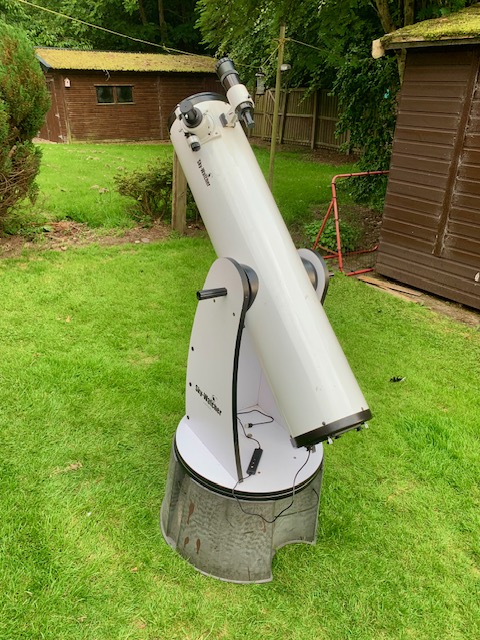
A Work Commenced June 21 2025
Back in 2015, I parted company with refractors as my main astronomical viewing instruments, having ‘seen the light,’ as it were, when I acquired a brilliantly simple 200mm F/5.9 Dobsonian from Skywatcher. Once properly collimated and acclimated under good seeing conditions, it significantly out-performed a top-rated 5 inch F/12 refractor on pretty much everything. The experience radically changed my perception of the true value of refractors, particularly when scaled up beyond 5 inches.
A year ago, I was delighted to see an astro imager had performed a shootout between a Skywatcher Explorer P 200mm F/5 Newtonian and a high-end 5 inch F/7.8 ED refractor on a high resolution lunar target, showing clearly the former’s superiority despite a nearly five-fold price differential.
Over the last decade, I’ve made a series of modifications to this 200mm Newtonian, called Octavius, owing to its 8 inches of aperture. The primary mirror from Skywatcher was good but I decided to replace it with a true 8-inch (203mm) F/6 Ultra Grade mirror with an accuracy exceeding 1/10th wave PV from Orion Optics UK, which also came with state of the art reflective coatings – HiLux enhanced aluminium – increasing the mirror’s reflectivity from 85 per cent to over 97 percent across the visible spectrum.
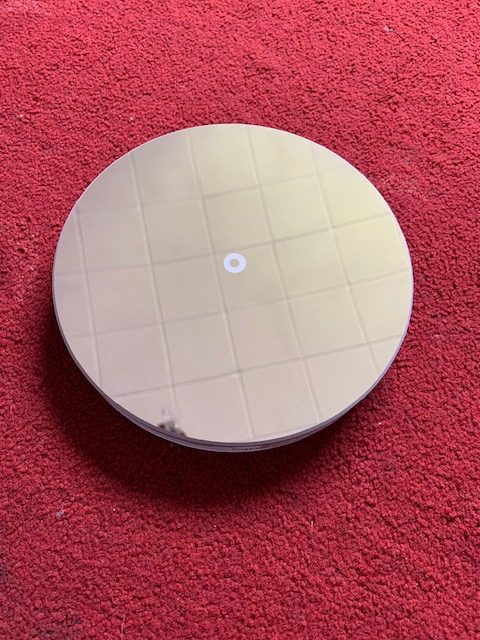
I then upgraded the secondary mirror by ordering up a smaller(1.52 inches) and more optically flat Antares unit with a 1/15th wave PV surface accuracy, whilst also reducing the central obstruction to less than 20 per cent by aperture.
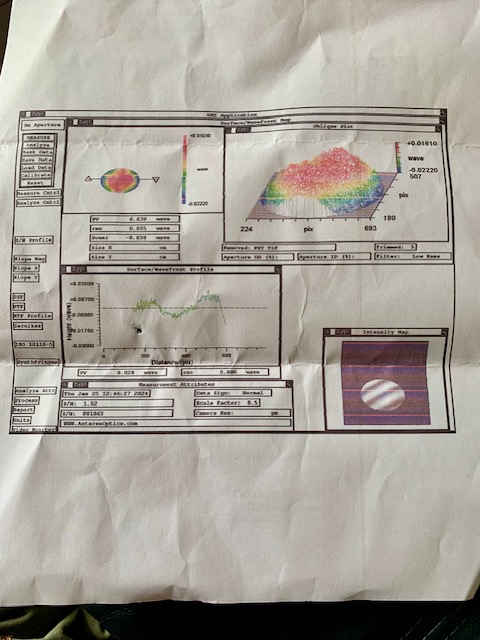
Like the primary, the small secondary mirror came with enhanced aluminium coatings as standard, to maximise image brightness. Because it’s such a small and lightweight mirror, I could attach it to the stalk using double-sided tape.
My own personal experience with enhanced aluminium coatings is that they have much greater longevity compared with standard coatings. Indeed I have older mirrors treated with HiLux that are 10 years old and show no signs of deterioration despite regular use in my damp Scottish climate.
The somewhat flimsy secondary housing on the original SkyWatcher 200P was removed and replaced by a much more rigid and solidly-built structure manufactured by the German company, BackYard Universe.
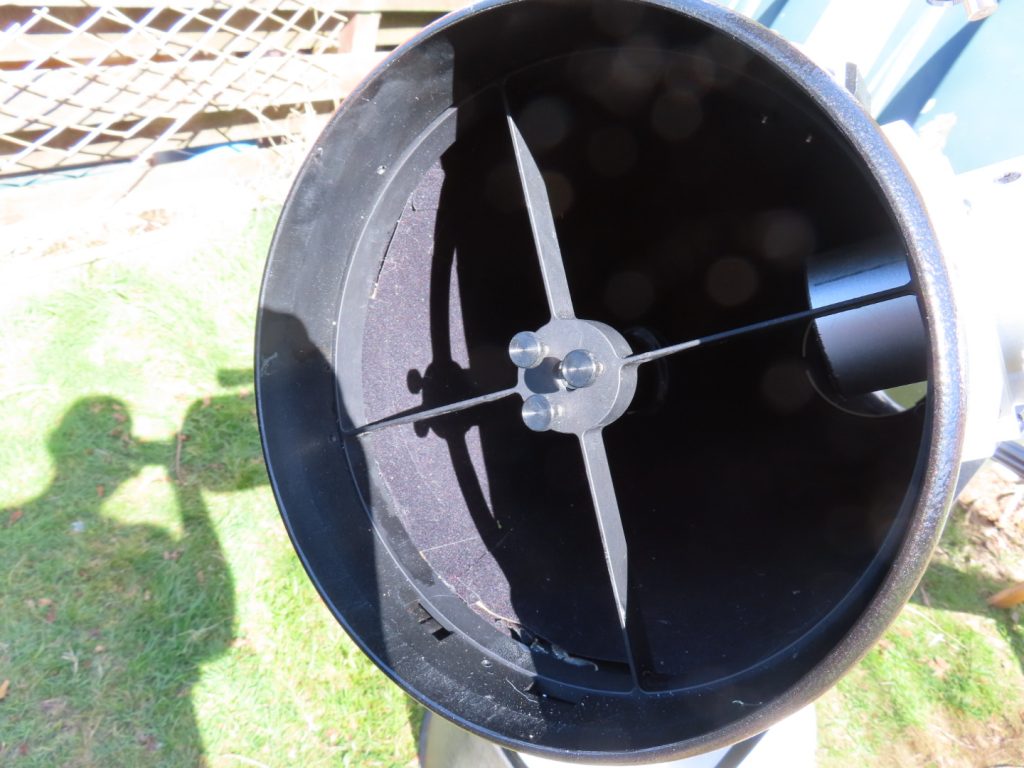
The secondary holder has a diameter of 40mm – slightly larger, in fact, than the 38.6mm elliptical flat mirror – giving a minimum central obstruction of 19.7 per cent.
Of course, If I so desired, I could have installed a low-profile focuser and decrease the secondary obstruction to just 10 per cent using a even smaller secondary, not to mention the need to redesign the spider structure. But in the end I decided against it, as I wanted to create a more all-purpose visual instrument rather than a specialised lunar and planet killer. And in any case, optical theory informs me that once the central obstruction falls below 20 per cent or so, the effects are almost indiscernible from a non obstructed optic of the same aperture.
I did however replace the original single-speed rack and pinion focuser on the SkyWatcher Explorer P after ten years of heavy use, with SkyWatcher’s dual-speed Crayford focuser, which allows me to achieve smooth and precise micro-focusing on high resolution targets.
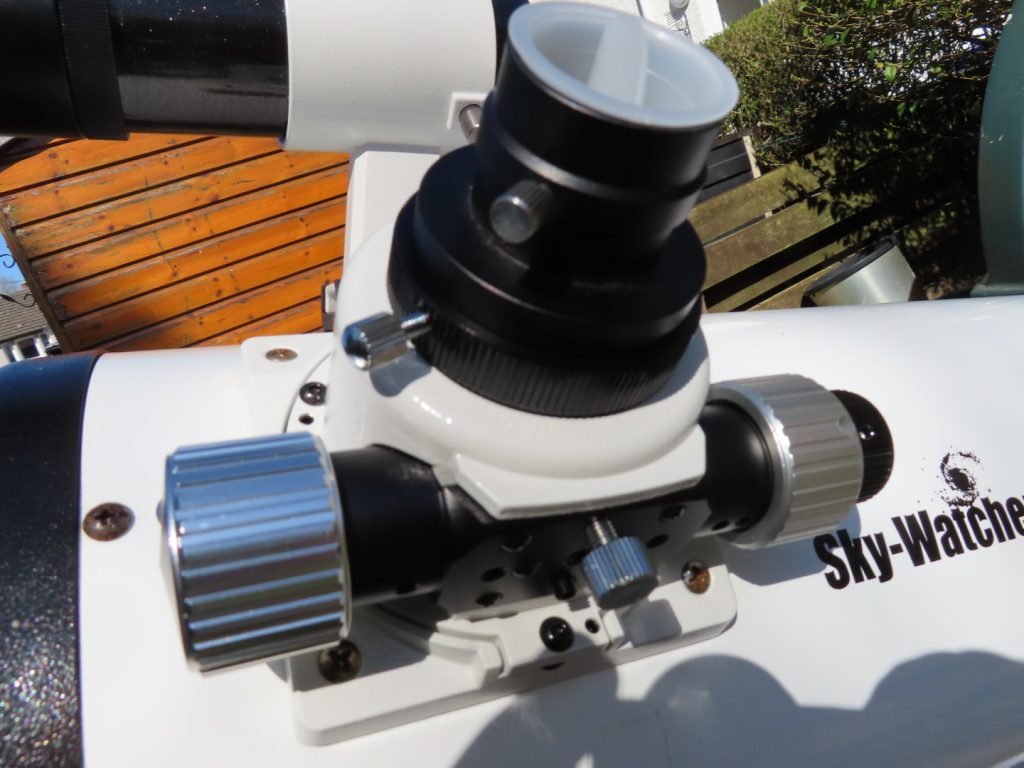
I also attached an inexpensive USB type cooling fan to the rear of the primary mirror which helps remove the boundary layer of warm air accumulating above the surface of the mirror, to help keep the images as crisp and detailed as possible.
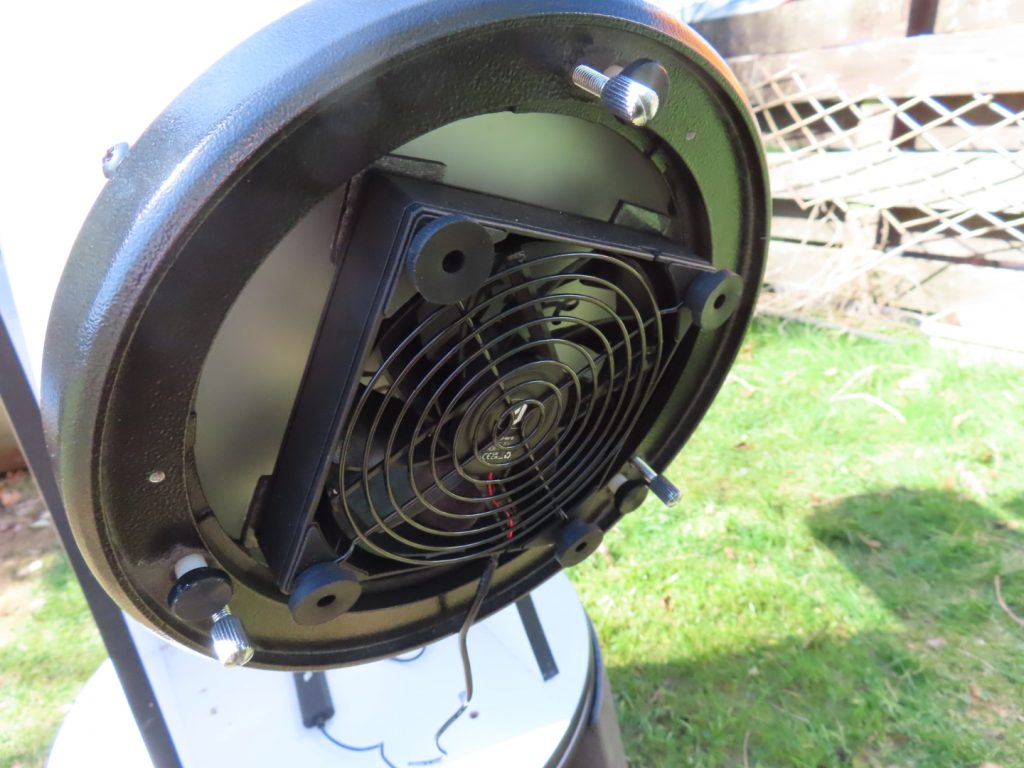
The interior of the tube is lined with cork and overlaid by matt black flocking material to further enhance its thermal properties, as well as maximising image contrast.
The telescope sits in the original lazy susan altazimuth mount with the stalks under its base fitting into some pre-cut holes I made in an inexpensive plastic water butt. This raises the height of the telescope further above the ground providing a supremely comfortable standing height – I’m a six footer – for all my astronomical observations. And that brings me to the second reason for abandoning refractors- I hate sitting down, huddling over an eyepiece, straining my back while trying to study a target located high in the sky. Those kinds of observations are much more comfortably executed while standing up. Indeed, I even use my travel scope- a high quality 130mm F/5 Newtonian placed on an altazimuth mount- in exactly the same way i.e. standing up. Once I got used to standing with my Newtonians, there was no going back to refractors.

Just as any fine musical instrument benefits from occasional tuning up, so too does Octavius. At F/6 collimation is very easy, so easy in fact that it only requires a simple collimation cap to get you 90 per cent of the way there, and quite often better. The final tweaking is done manually by performing a star test at high power and making those final adjustments using the collimation screws on the primary mirror. It’s quick and easy, taking only a couple of minutes to get perfect alignment of the optics.
The more rigid secondary structure has greatly helped to maintain precise collimation from night to night, so much so that the instrument only needs occasional tweaking when moved from its indoor storage space to the outside air. That’s how it should be!
So how good are the optics? In a word- superb! But to elaborate: star testing at 200x under good conditions shows identical diffraction patterns inside and outside focus. Stars focus down to tiny, round Airy disks. By far the biggest benefit has come from the primary mirror. On the night the new primary arrived back in January, I was immediately able to discern the improvement on Jupiter. The new mirror snapped to focus better, showed more contrast and routinely revealed subtle details on the Giant planet that I had only vaguely discerned using the original mirror. Magnifying the first quarter Moon up to well beyond 400x showed no image breakdown whatsoever. The image below is a single shot image of the first quarter Moon taken with the Svbony SC001 2 Megapixel imaging camera, on the evening of May 3 2025, showing some very fine details.
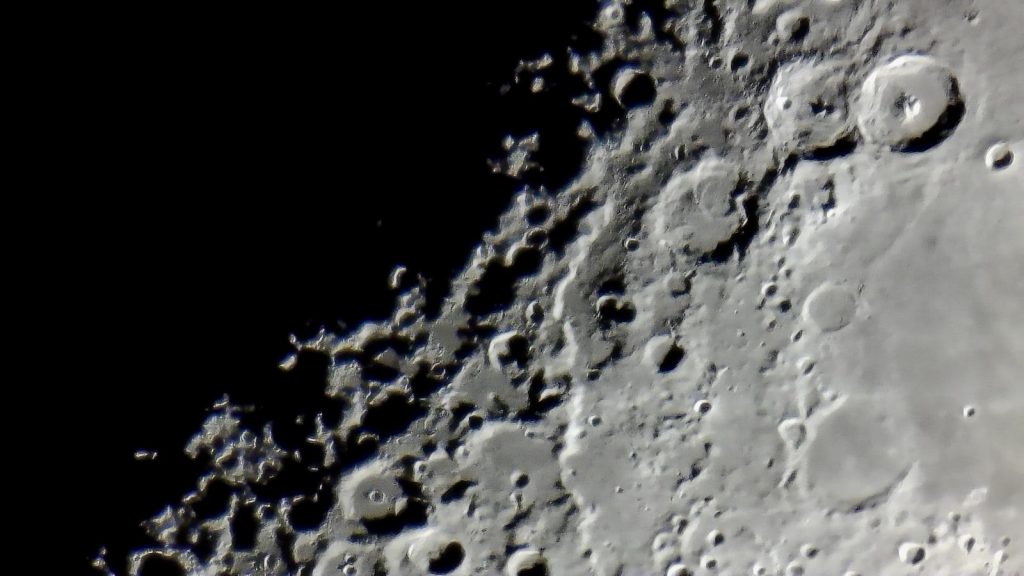
Know Thy Telescope
Modern Newtonian primary mirrors are figured into the shape of a parabola. But why a parabola? Some analytical geometry can help us understand why:





In contrast, a spherical mirror has no fixed focal point but can approximate a parabolic shape if the focal ratio is made very large. Unfortunately, as the aperture increases, the focal lengths needed for spherical mirrors to work well very quickly
become impractical.
Optimum Aperture for Resolving Binary Stars.
Octavius is used mainly as a lunar, planetary and double star scope, although I also use it for deep sky observing too. One of my passions is double star observing, at which Octavius excels. Indeed, with a decade of experience with this telescope, I’ve come to accept that it’s very close to ideal for observing tricky binary systems reaching pairs less than 1” separation.
The following analysis is based on the work of Michael Greaney from chapter 25 of the book, Observing and Measuring Double Stars(2nd edition) which was incorrectly printed( the errors from which were reported by yours truly ,to the editor, Bob Argyle, at the Institute of Astronomy, Cambridge, UK).
According to Sidgwick, the maximum useful magnification of a telescope is approximately 28D^0.5 where D is the aperture of the telescope in millimetres. This was empirically derived, so has taken the effects of atmospheric seeing under British skies into account.
On the other hand, according to the work of the late professional double star astronomer, Dr Paul Couteau, the minimum useful magnification for resolving close binary stars is twice the resolving magnification of the telescope, which turns out to be D in millimetres.
There must exist an optimum value of D between the maximum useful magnification and the minimum useful magnification. If we express this as f(D) = 28D^0.5 – D
Then differentiating with respect to D gives:
f’(D) =14D^-0.5 -1 = 0 for the optimum, which turns out to be D =14^2 =196mm.
This result is just shy of 8 inches, the same aperture as Octavius.
Octavius, Optimus!
A Mid-Summer Night’s Dream

I’ve noted the efficiency of the 8-inch F/6 Newtonian many times over the years, but as a case in point, I used the instrument on two nights just after the summer solstice to resolve some tricky double stars at high power. First on the night of June 24-25 and again on June 28-29 2025. My workhorse eyepiece for this kind of project is my trusty Svbony SV 215 3-8mm planetary zoom eyepiece yielding magnifications of 152x – 406x. As the experienced observer, Alan Dyer, of Sky & Telescope concluded in his review, this is an excellent eyepiece, fully the equal of the Nagler zooms but offered at a much more attractive price. Additionally, I usually have 1.6x, 2x and 3x Barlow lenses handy to boost the magnification as high as 1218x.

This time of year, the twilight limits my observations to a short period of time between 11:30pm and about 1:00am local time, as any later and the sky begins to brighten again. I usually ‘warm up,’ starting with easier pairs such as Epsilon 1 & 2 Lyrae, all four components of which are easily split at 152x in the 8-inch. Moving on to Delta Cygni, which has a faint close companion, Octavius made light work of resolving this system at powers upward of 300x. One invaluable tool I use to enhance the detection of these close, unequal magnitude pairs is a polarising filter, which helps to cut off some of the diffraction ‘gunk’ between the components, in much the same way as an apodising filter works.
From there, I moved over to Aquila, low in the east, and tracked down the sixth magnitude star Pi Aquilae, centered it in my 8 x 50 finder scope and then cranked up the power to 406x, which is sufficient to tease both components – a pair of white sixth magnitude stars separated by just 1.4 arc seconds – and orientated roughly east-to-west.

Confident of good, steady skies, I next trained the instrument on Lambda Cygni – by now high in the eastern sky. Starting at 406x, I leave the star drift through the field, watching with intensity what the image might show me. Sure enough, I began to glimpse the secondary star (magnitude 6.3) almost precisely north of the primary(magnitude 4.7) and separated by a sliver of twilit space merely 0.9 arc seconds apart. Checking Stelledoppie afterwards, I was delighted to see its estimated position angle to be 01 degree, so almost immediately due north of its primary! Cranking up the power to 812x using a 2x Barlow lens gave an even more impressive view: the two stars cleanly resolved, and racing through the field of my un-driven telescope at breakneck speed! How swiftly the Earth moves! Time waits for no one.
At their distance from the solar system, the pair orbit their common centre of gravity every 391 years.

The above was recorded after midnight on June 25 but I was able to repeat the split just a few nights later on June 29. So, two clear nights just after the solstice when the telescope was able to resolve this sub arc-second pair! This might sound unusual, but it’s actually quite typical of our summer sky seeing – and, truth be told, all over the British Isles(having surveyed its suitability across Ireland as well),- here in rural central Scotland!
Unequal Pairs
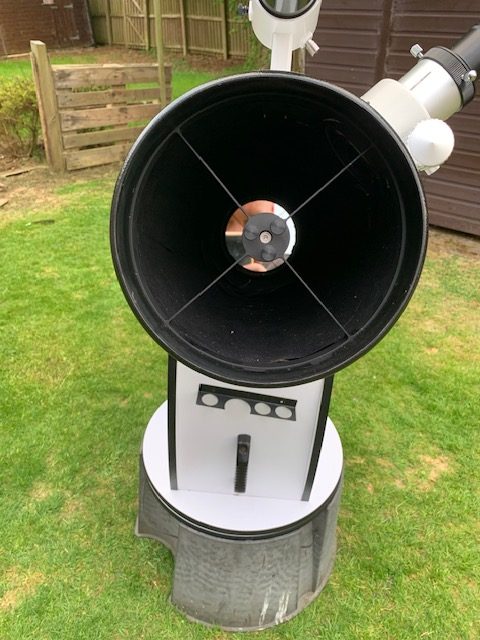
The Dawes Limit has long remained the empirical limit on the resolution of double stars. Formulated in the 19th century by the celebrated Victorian observer, William Rutter Dawes, it states that the resolution limit for a telescope in arc seconds is given by 4.56/D where D is the aperture in inches. The formula Dawes arrived at was for equal brightness 6th magnitude stars. Thus, Octavius ought to be able to resolve equal magnitude pairs as close as 0.57 arc seconds. But things get more challenging for pairs of unequal brightness. In short the bigger the brightness differential between the stars the harder they are to tease apart.
Of the closer pairs already discussed, the easiest is Pi Aquilae(1.4”), since they only differ in brightness by 0.41 stellar magnitudes. More challenging yet is Lambda Cygni (0.9”) with a brightness differential of 1.53 stellar magnitudes. But at 00.02h on the night of July 17, during a spell of excellent astronomical seeing, I trained Octavius on Zeta Herculis, a yellow-white sun-like star still high in the summer sky just past meridian passage. The secondary is separated from its primary by 1.53” but the magnitude differential is 2.45. Charging the telescope with a power of 650x using my polarising filter, the 8-inch Newtonian was easily able to resolve the secondary immediately due east of its primary( confirmed by consulting Stelledoppie). Another similar test of this kind can be conducted on Propus(Eta Geminorum)during the winter months. With a separation of 1.83” but a magnitude differential of 2.63, this is considerably easier to tease apart.
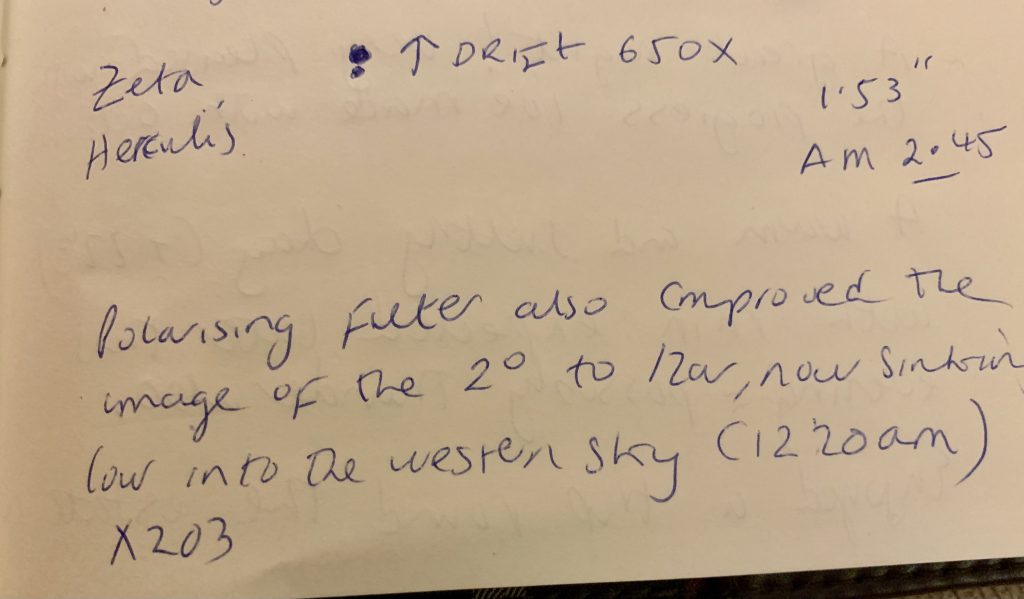
Why mention close, unequal pairs like these? Well, commonly accepted wisdom holds that Newtonians work best for equal magnitude pairs, but I’ve found this to be another myth promulgated by some members of the amateur community. After studying the work of Christopher Taylor, a theoretical physicist by training, and keen double star observer with a particular interest in resolving sub-arc second pairs using a 12.5 inch F/7 Calver reflector erected on a massive, un-driven altazimuth mount down at Oxford(discussed in Chapter 11 of Argyle’s book previously mentioned), it became clear to me why Octavius does so well on unequal double stars like Zeta Herculis. It has a small central obstruction and vanishingly low spherical aberration- both of which result in transferring substantially less energy from the Airy disk into the diffraction rings, thereby making a faint companion more easily resolvable from its primary. Indeed, Taylor admits as much in his book chapter, by making the point that his century-old Calver mirror was deliberated left under-corrected to help keep track with falling temperatures.
Examining the Airy disks of second and third magnitude stars in Octavius on nights of good seeing, reveals tiny pinpoint stars with a singular ring of moderate size and brightness. In other words: the images are very refractor-like.
Perhaps most fascinating of all is the sheer dynamism of pairs like Zeta Herculis. Located a few tens of light years away, the companion to Zeta Herculis orbits its primary in just 34.5 years. That means that its position angle relative to its primary changes significantly in just a few years! Having carried out observations of this system regularly over the last decade I’ve witnessed its rapid movements from one year to the next. How cool is that?
For the record, Tau Cygni, easy to pick up even in summer twilight, and currently separated from its primary by 1.1” but with a 2.75 magnitude difference, presents a similar type of challenge.
A New and Improved Primary Mirror Fan

I’ve dithered for years about whether a primary mirror cooling fan would be worth installing. I’ve generally not encountered much in the way of thermal issues using Octavius, as we experience only small diurnal temperature swings for much of the year, though April and May have brought their problems, with warm sunny days and chilly nights. I generally store the telescope in a dry, unheated shed, just a few degrees warmer than the outside air. However, during the cold winter of 2024-25, I bought a small USB desk fan and affixed it to the rear of my primary mirror using a few layers of double-sided tape. It was powered by a small portable power pack and after several trials,I became convinced that it did clean up the images of Jupiter and Mars in a subtle but consistent way. However, I did perceive some vibrations at the high powers I use for close double stars. I attributed this to the direct attachment of the fan to the mirror.
So I decided to splash out on a dedicated mirror fan manufactured by Austral Solutions, based in Spain. This new fan attaches to the outer tube of the telescope in such a way that it doesn’t touch the primary directly, but blows ambient air onto to the centre of the primary mirror. It’s powered by a 12v DC step-down transformer (user provided)powered from a mains (AC) source. Although this requirement necessitates having a constant supply of electricity, it’s more reliable than the portable power pack I had used with the original fan, which often cut out, especially on colder evenings, over the winter and spring. My results this summer, examining high-resolution double stars, testing various permutations (turning the fan off and on and critically examining the seeing disks) has convinced me that keeping the fan running constantly significantly increases the stability of the Newtonian image.
Finding Fainter Pairs
By late July, the skies above me become noticeably darker, allowing me to better track down fainter binary star systems. One example is Mu Cygni, which can now be tracked down using my finder scope on the eastern flank of this large, summer constellation. My notes show that I had not visited this system for about six years, so I was excited to pay a visit to this old friend. On the night of July 23-24, I trained Octavius on Mu, which is easily identified by virtue of a wide, unrelated 7th magnitude star off to the east of it in the finder telescope. Charging Octavius with a power of 406x(fan running), I was greeted by a beautiful sight: a pair of white suns separated by 1.6”, the primary having a magnitude of 4.8 and the secondary- 6.2-roughly due north of it. I don’t remember this system to be much of a challenge for a good 4- or 5-inch refractor employing high powers back in the day. Clearly the secondary is closing in on the primary, making it more challenging than I remember.

In addition, on the same night, I trained Octavius on Iota Cassiopeiae, now at a decent altitude off to my northeast, and cranked the power up to about 200x to reveal this beautiful triple system for the first time this season. A nice way to end my vigil on this rather cool July night!
A Return to Dark Nights
By the last week of July, the skies are turning noticeably darker after sunset here in rural central Scotland. On the night of July 29-30, I enjoyed a reasonably calm, clear sky and by half past midnight local time, I could once again see the faint glow of the summer Milky Way coursing its way through Cygnus and Cassiopeia. Seeing was only average though, so no high-resolution double star observing was conducted. Instead I turned Octavius on some familiar summer deep sky objects. To view some of the larger objects on display, I employ longer focal length 1.25” eyepieces like my 22mm (70 degree AFOV) yielding a low power of 55x in a true field of 1.26 degrees and a medium power from my 15mm (68-degree AFOV) which yields a power of 81x in a 0.84 degree field. The reader will note that I do not employ 2” eyepieces for lower power wider FOV viewing for two principal reasons: I strongly dislike having to switch between the 1.25” and 2” formats, and the lower powers of these longer local length oculars shows up the astigmatism in my right observing eye which I find distracting when used without eye glasses. That said a 1.26 degree field is more than enough to enjoy pretty much all of the objects I visit with Octavius. If I want larger fields, I turn to my large, 15 x 56 binoculars.
I first turned Octavius on the Ring Nebula(M57) in Lyra, its ghostly glow coming through nicely at 152x. Then moving into Hercules, I quickly located both M13 and M92, both globular clusters located far out in the halo of our galaxy. Although these are best resolved at powers of 150x to 200x, tonight I was happy to admire these beautiful baubles of ancient starlight at 81x using my 15mm eyepiece.
After having quick looks at easy double stars such as Gamma Delphini and the colourful, O1 and O2 Cygni and the famous 61 Cygni, I trained the telescope on the wide but rich open cluster M39 at the head of Cygnus, enjoying the dozens of pinpoint stars strewn across the field of the 22mm eyepiece, and set against a rich Milky Way hinterland. By 1:00 AM local time, Cassiopeia was just clearing my rooftop and I had hoped to catch a glimpse of the famous Double Cluster in Perseus. Alas it was still too low for me to access it. It will have to wait a wee while longer before I can view this spectacular object in my trusty 8 inch Newtonian.
The Assault on Tau Cygni
The night of August 9-10 was cool and breezy, but the sky was clear, with relatively calm twinkling stars..The full Moon culminating low in the south. I fielded Octavius at around 10:30pm local time and tested sky conditions by looking at a few binary systems of increasing difficulty. First I targeted Delta Cygni and was delighted to get a very clean split at 244x. Then I moved over to Lambda Cygni, cranked the power up to 650x and once again managed to split this system with relative ease. Confident that this would be a good night to try my hand at Tau Cygni, I began by observing the star at powers up to 406x but with not a lot of success. Patience is a virtue, however. The system had a few hours to go before it reached its highest altitude crossing the meridian. Leaving the fan running continuously, I covered the optics and ventured inside for a while before returning to the telescope every half hour or so. With each attempt, I could see that the appearance of the Airy disk of the 4th magnitude yellow white primary looked better and better as I was looking through less atmosphere. After midnight, using a power of 812x , I got my first glimpse of the secondary with a current separation of about 1” off to the SSE of the primary but it was only tentative at this stage. By about 1.00AM local time, I ventured out again, charging the instrument with a power of 812x and positioned the star on the east side of the telescopic field. In moments of superior seeing, I could make out a faint disk in the same position I had glimpsed earlier, but now it was more steadily held. Reaching for my 3x Barlow and switching it out with my 2x Barlow, the telescope could now deliver a power of 1218x – crazy I know! To see this system at such high power on an un-driven mount, you start at the lowest zoom setting (8mm with a 3x magnification boost), placing the star at the eastern edge of the field, focus as finely as possible and then crank the power upwards toward 1218x. The strategy paid off! At these extremely high powers, I was better able to tease the components apart and record its position relative to the direction of drift. After I had made a sketch, I consulted Stelledoppie and was delighted to see that the companion was in just the right position it should be in August 2025. I note the last measure was made back in 2017 when the estimated position angle was 190 degrees. Since then the 7th magnitude companion had moved eastward in its orbit round the primary. Back in 2017, it was located off to the SSW but now it was in a SSE direction.
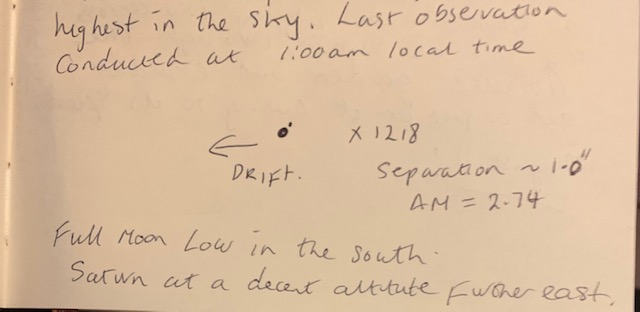
This was a thrilling observation: one of the most difficult I’ve tried in quite some time: a companion separated by just 1” of sky but fully 2.74 magnitudes fainter! This would be a severe challenge for a 6-or 7-inch refractor but it was quite doable on a good night here in rural central Scotland, using a fine-tuned 8-inch Newtonian with a sub-20% central obstruction. The sun-like star Tau Cygni B, orbits its primary every 49.5 years.
A Visit to 61 Cygni:
In the same telescopic field as Tau Cygni my 8 x 50 finder scope picks up the lovely pair of orange stars known as 61 Cygni. Even the smallest telescope is capable of resolving these stars and even steadily held 10x binoculars should tease these apart. At 153x Octavius frames these stars perfectly with a nice Milky Way background. The brighter of the two has a magnitude of 5.2 and its companion nearly a full visual magnitude fainter. To my eye both stars exhibit the same orange hue and that’s not surprising as they are both K spectral class dwarf stars with temperatures a little over 4000K. 61 Cygni was all the rage in the first few decades of the 19th century, when astronomers noted their large proper motion, a good sign that these stars were relatively close to the solar system. As recounted in great detail in Chapter 11 of my large historical work, Chronicling the Golden Age of Astronomy, it was the great German astronomer, Friedrich Wilhelm Bessel, who, by 1840, first measured their distance from the solar system to be 10.3 light years away: only 10 percent lower than the modern accepted value. 61 Cygni represents a true binary star system, the components of which orbiting their common centre of gravity every 680 years.
Astronomers have yet to identify planets orbiting these cool, long-lived stars, but in general, unless their planets orbit very close to their parent stars, the chaotic orbital motions of close binary star systems like this generally cause their planets to be ejected from their system over time. Still, in the mind’s eye, I can imagine being on the surface of one such world, watching two golden suns rising and setting in a clear sky. How wonderful it would be to witness such a sight!
Two Golden Binary Stars in Draco:
On the lovely evening of August 26, a light southerly wind kept the dew at bay and the sky above was glorious, with the Milky Way snaking its way from southwest to northeast. I trained Octavius on Eta Draconis: a lovely golden sun easily visible to the eye at magnitude 2.7. This was my third observation of this system in as many weeks. Seeing was excellent tonight as is often the case in August, so I cranked the power up to 406x and watched it drift through the field. It wasn’t long before I glimpsed its very faint secondary close in at 4.7” from the primary, and off to the southeast. The challenge here, once again, is not the angular separation per se, but rather the magnitude differential. The companion is 5.4 magnitudes fainter but still quite easy for Octavius.

Returning to the lowest power setting on my zoom eyepiece yielding 152x, brought another star of the 6th magnitude of glory into the same field of view as Eta. Indeed it is quite easily seen in my 8 x 50 finder. This star, known prosaically as STF 2054, also took on a golden hue but after I increased the power to 406x I could easily resolve its companion just 0.93” away from the primary and orientated north-south( the companion is due north). The fainter star is about a magnitude dimmer than its primary. Using my 2x Barlow lens provided 812x which made seeing the components that little bit easier again. Intriguingly, after consulting the astrophysical data on both Eta Draconis and STF 2054, I discovered that both stars have exactly the same spectral class – G8III – making them about 700 degrees cooler than our Sun but also explaining why their colours looked similar in the eyepiece.These two stars visible in the same field will make for an excellent test of resolution for moderate-aperture backyard telescopes under good seeing conditions.

To be Continued……
Dear Neil, thank you so much for your kindest appreciation of reflectors 🙂
Another advantage I appreciate is that one can use detailed star chart for eyepiece hopping by just rotating them 180 degrees. With a refractor, one must mirror vertically what one sees in the chart with what one sees at the eyepiece.
Looking forward to more adventures with Octavius. You inspired me to call mine Decimus 😉
Best regards,
Pietro
Dear Pietro,
Thanks for your message. Yes, I’m very proud of Octavius and will be reporting on my adventures with it. Much more to come.
Enjoy Decimus!
Best,
Neil.